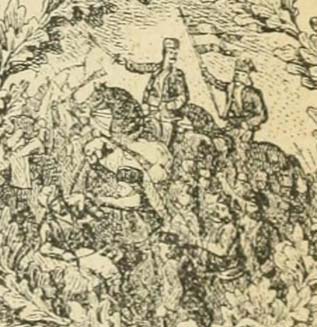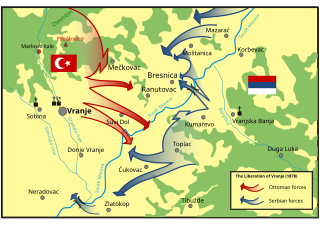
Stevan Sinđelić was a Serbian revolutionary commander in Resava, who fought during the First Serbian Uprising (1804–1813) against Ottoman rule. As the commander of the Resava Brigade, he fought in many battles and skirmishes against Ottoman foot-soldiers, including the Battle of Ivankovac in 1805 and the Battle of Deligrad in 1806. He is remembered for his actions during the Battle of Čegar Hill in 1809, in which he and the Resava Brigade found themselves surrounded by the Ottomans. Encircled and without much chance of survival, Sinđelić ignited the gunpowder kegs in the powder cave, creating an enormous explosion that killed him, along with all of the Serbian and Ottoman soldiers in his trench.

The First Serbian Uprising was an uprising of Serbs in Orašac against the Ottoman Empire from 14 February 1804 to 7 October 1813. Initially, a local revolt against renegade janissaries who had seized power through a coup, it evolved into a war for independence after more than three centuries of Ottoman rule and short-lasting Austrian occupations.

The Russo-Turkish War (1806–1812) between the Russian Empire and the Ottoman Empire was one of the Russo-Ottoman Wars. Russia prevailed, but both sides wanted peace as they feared Napoleon's moves to the east.

A series of military conflicts between the Ottoman Empire and various European states took place from the Late Middle Ages up through the early 20th century. The earliest conflicts began during the Byzantine–Ottoman wars, waged in Anatolia in the late 13th century before entering Europe in the mid-14th century with the Bulgarian–Ottoman wars. The mid-15th century saw the Serbian–Ottoman wars and the Albanian-Turkish wars. Much of this period was characterized by Ottoman expansion into the Balkans. The Ottoman Empire made further inroads into Central Europe in the 15th and 16th centuries, culminating in the peak of Ottoman territorial claims in Europe.

The Battle of Sarikamish was an engagement between the Russian and the Ottoman Empires during World War I that took place from December 22, 1914, to January 17, 1915, as part of the Caucasus campaign.

Count Joseph Cornelius O'Rourke (1772–1849) was a Russian nobleman and military leader of Irish origin who fought in the Napoleonic Wars and achieved the rank of lieutenant general. He is noted for leading a campaign against the Turks in present-day Serbia, where a combined Russian and Serb army defeated the Ottoman Empire at Varvarin in 1810.

The Battle of Monastir took place near the town of Bitola, Macedonia during the First Balkan War, between Serbian and Ottoman forces from 16 to 19 November 1912. It resulted in a Serbian victory after heavy fighting north of the city, the routed Turks fled abandoning their guns.

Varvarin is a town and municipality located in the Rasina District of central Serbia. Population of the town is 2,133, and population of the municipality is 17,772.

The Battle of Akhaltsikhe may refer to one of the following:

The Battle of Kulevicha, also known as the Battle of Kulevcha or Kulewtscha, was fought during the Russo-Turkish War, 1828-1829 on 11 June 1829 between Russia and the Ottoman Empire.

The Battle of Ivankovac was the first full-scale confrontation between Serbian revolutionaries and the regular forces of the Ottoman Empire during the First Serbian Uprising.

The German Caucasus expedition was a military expedition sent in late May 1918, by the German Empire to the formerly Russian Transcaucasia during the Caucasus Campaign of World War I. Its prime aim was to stabilize the pro-German Democratic Republic of Georgia and to secure oil supplies for Germany by preventing the Ottoman Empire from gaining access to the oil reserves near Baku on the Absheron Peninsula.

The Battle of Mišar was fought between Serbian revolutionaries and an Ottoman army, it took place from 12 to 15 August 1806 during the First Serbian Uprising. After repulsing a Turkish force at Ivanovac the Serbian insurgents under Karađorđe took strong position, entrenched in sconces on the field of Mišar Hill, near Šabac west of Belgrade. For two consecutive days they faced costly assault by a Turkish army and its Bosnian allies. On the third day, the Serbian cavalry attacked and defeated the Turks, the insurgents then conquered the citadels of Šabac and Belgrade.

The siege of Scutari, also referred to as the siege of Shkodër, known in Turkish as İşkodra Müdafaası(in Turkish) or İşkodra Savunması, took place from 28 October 1912 to 23 April 1913 when the army of the Kingdom of Montenegro defeated the forces of the Ottoman Empire and invaded Shkodër.

The siege of Silistria, or siege of Silistra, took place during the Crimean War, from 11 May to 23 June 1854, when Russian forces besieged the Ottoman fortress of Silistria. Sustained Ottoman resistance had allowed French and British troops to build up a significant army in nearby Varna. Under additional pressure from Austria, the Russian command, which was about to launch a final assault on the fortress town, was ordered to lift the siege and retreat from the area, thus ending the Danubian phase of the Crimean War.
The Battle of Slobozia was fought between Russia and the Ottoman Empire as a part of the Napoleonic Wars during the Russo-Turkish War of 1806–1812. The primary battle occurred on the left bank of the Danube River near the small village of Slobozia in Wallachia. Four miles to the southeast on the right bank of the Danube was the Ottoman fortress at Rusçuk. The siege of the Ottoman forces at Slobozia including the final battle lasted approximately two and half months from 28 August to 14 November 1811, ending when Russian Commander Mikhail Kutuzov ultimately accepted the surrender of the Ottoman forces commanded by Ahmed Pasha.

The Serbian–Ottoman Wars, also known as the Serbian–Turkish Wars or Serbian Wars for Independence, were two consequent wars, fought between the Principality of Serbia and the Ottoman Empire. In conjunction with the Principality of Montenegro, Serbia declared war on the Ottoman Empire on 30 June 1876. By the intervention of major European powers, ceasefire was concluded in autumn, and the Constantinople Conference was organized. Peace was signed on 28 February 1877 on the basis of status quo ante bellum. After a brief period of formal peace, Serbia declared war on the Ottoman Empire on 11 December 1877. Renewed hostilities lasted until February 1878. Final outcome of wars was decided by the Congress of Berlin (1878). Serbia gained international recognition as an independent state, and its territory was expanded.

The siege of Calafat took place in 1854 during the Crimean War. The Russians unsuccessfully besieged the Ottoman army at this place for four months before finally withdrawing.

The Battle of Loznica also known as the Battle of Tičar was fought on 17–18 October 1810 between Serbian Revolutionaries and Ottoman forces in Loznica, at the time part of the Sanjak of Zvornik, a region of the Ottoman Empire,.

The Battle of Vranje, or the Liberation of Vranje, represented one of the final stages of the second phase of the Serbian–Ottoman War (1876–78). At the beginning of the war, the Serbian army began the offensive in what is today South Serbia. After the Battle of Grdelica, the Serbian army managed to break into the Masurica Valley leaving the road to Vranje open and unguarded. At the same time, many rebellions broke out in the Serbian-Ottoman border areas, including in the Vranje region, against Ottoman authority. To help the rebels, the Serbian command decided to send Lieutenant Stepa Stepanović to form a special rebel battalion.


















